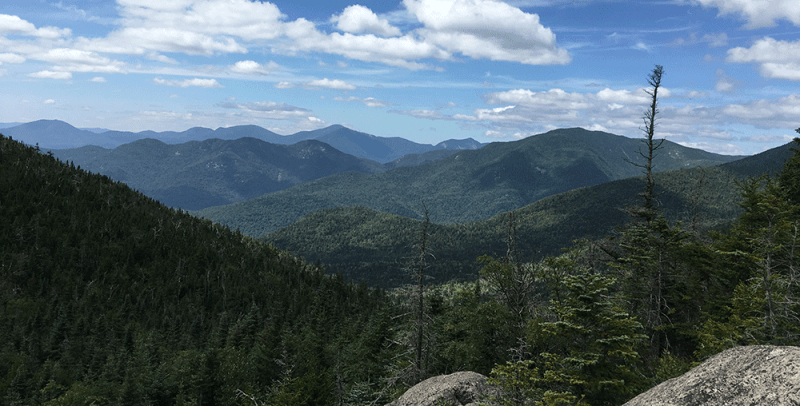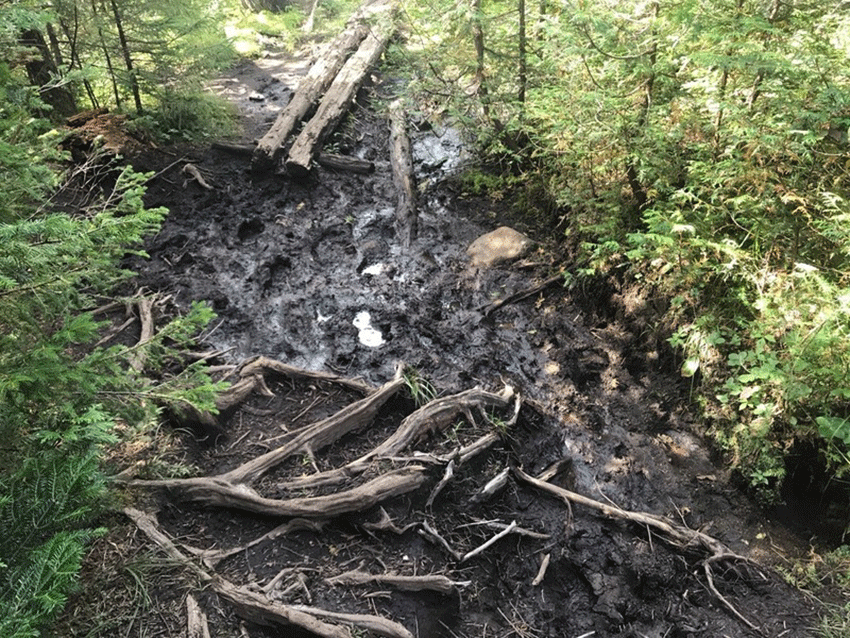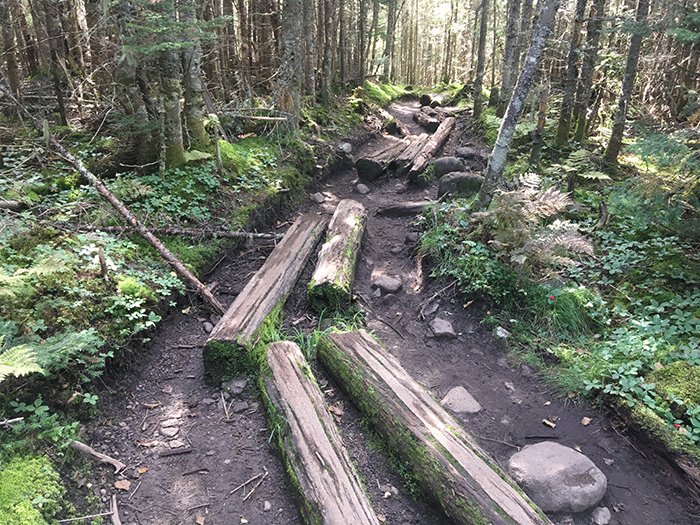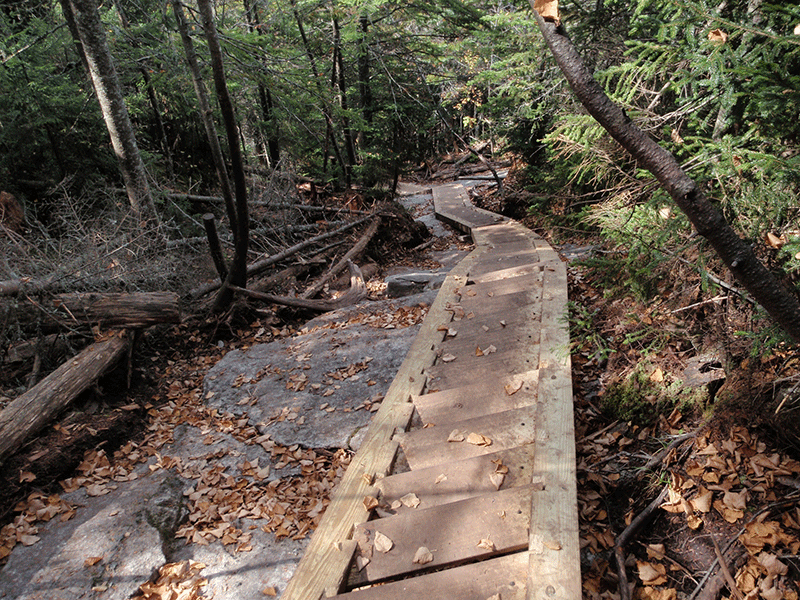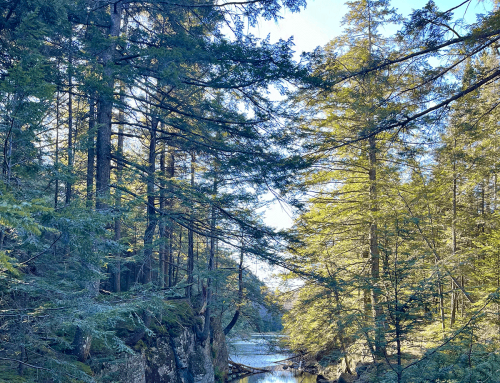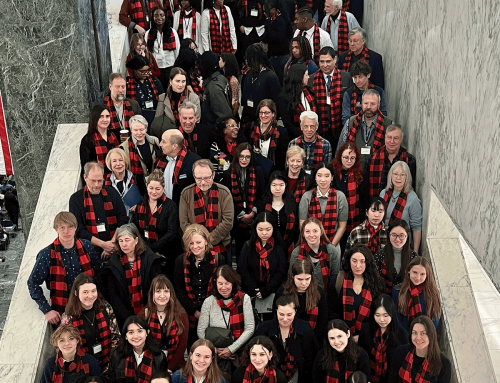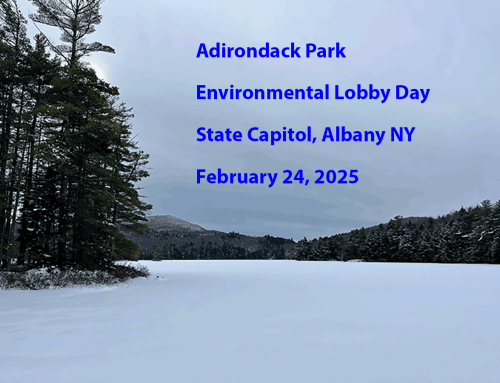The 275,000-acre High Peaks Wilderness is New York’s premier wilderness area. The High Peaks Wilderness is the 3rd largest wilderness area east of the Mississippi River. Public use has rocketed in recent years due to a combination of factors, but one thing should be clear to state planners: There is no other place, anywhere near the High Peaks, that offers the staggering beauty of the rugged landscape and mountain views that a hiker gets from standing atop an interior High Peak mountain summit circled by dozens of other mountains. The High Peaks Wilderness has been a bipartisan, multi-generational success to create the largest and grandest Wilderness in New York State that protects the state’s highest mountains.
Management of the High Peaks Wilderness, in the decades before and after the Adirondack Park State Land Master Plan, by the State of New York has always been weak. The region has never received the type of management, investment, infrastructure, and personnel necessary to effectively protect the natural resources and manage public use. A comprehensive management program for the High Peaks that includes public education, scientific monitoring of natural resources and public use, development of facilities consistent with a Wilderness area, and the construction of safe, sustainable hiking trails has been elusive for decades.
Protect the Adirondacks congratulates the Department of Environmental Conservation (DEC) for focusing a new inquiry on the management of the High Peaks Wilderness and other adjacent Wilderness areas. The extraordinary beauty of this region, the stunning array of natural resources, its popularity with the hiking public, and its enormous role in attracting hundreds of thousands of visitors to the northern Adirondacks each year, demands that this region receive the best management that the State of New York can muster.
One hallmark of the Andrew Cuomo years is poor strategic investment in economic development, community development, and in building viable institutions in the Adirondack Park. The Cuomo Administration spends extravagantly on poor long-term investments, such as the Frontier Town Campground. The economic development strategy of the Cuomo Administration appears to be to give hundreds of millions to ORDA facilities and then get area boosters to call things like culvert upgrades and construction of salt sheds economic development projects. This has shortchanged Adirondack communities as the region collectively spins its wheels. One profound missed opportunity of the last 10 years is the failure of the Cuomo Administration to invest in the High Peaks Wilderness.
Wilderness Values Must Determine Wilderness Management: The fundamental purpose of a Wilderness area is that is a protected landscape where ecological processes are allowed to proceed unimpacted by humans to the greatest extent possible. As a result, human impacts are minimized to those caused by walking, paddling, or cross-country skiing. A central tenet of Wilderness area management is the absence of motor vehicles or bicycles from a large landscape. Wilderness areas by their basic definition are supposed to receive the lightest of impacts from human recreational activities. The Adirondack Park State Land Master (APSLMP) articulates this purpose in its basic definition of Wilderness:
A wilderness area, in contrast with those areas where man and his own works dominate the landscape, is an area where the earth and its community of life are untrammeled by manâ€â€where man himself is a visitor who does not remain. A wilderness area is further defined to mean an area of state land or water having a primeval character, without significant improvement or permanent human habitation, which is protected and managed so as to preserve, enhance and restore, where necessary, its natural conditions, and which (1) generally appears to have been affected primarily by the forces of nature, with the imprint of man’s work substantially unnoticeable; (2) has outstanding opportunities for solitude or a primitive and unconfined type of recreation; (3) has at least ten thousand acres of contiguous land and water or is of sufficient size and character as to make practicable its preservation and use in an unimpaired condition; and (4) may also contain ecological, geological or other features of scientific, educational, scenic or historical value. (p 22)
The basic Wilderness definition states that lands classified as Wilderness should be managed in a wild, natural, untrammeled state where any impacts or marks of humans are difficult to detect. In the High Peaks Wilderness, two longstanding realities of public use have long undermined the APSLMP directive stated above: 1) the sheer high numbers of people that recreate in certain parts of the High Peaks at certain times; 2) the impacts from these high numbers of people have degraded the natural resources in plainly visible ways in many parts of the High Peaks.
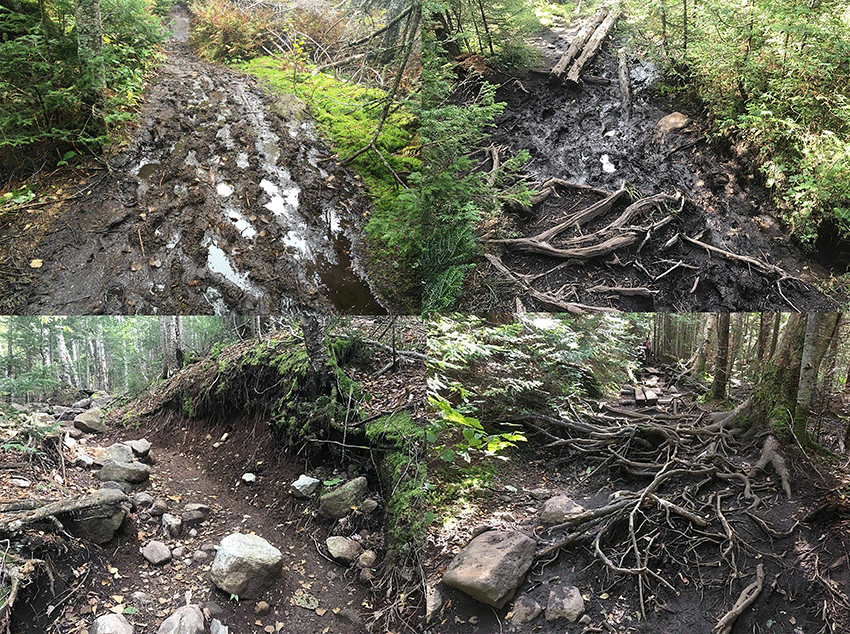
These pictures show hiking trails in the High Peaks Wilderness that need rehabilitation. The disrepair of many hiking trails in the High Peaks fail to meet the Wilderness management objective that the “imprint of man’s work substantially unnoticeable.” These scars are clearly noticeable and cross-cross the High Peaks region.
A hike up Giant Mountain, or Blake Mountain, or Mount Colden, or pick any other major peak, would hardly appear to any hiker as lands that “have been affected primarily by the forces of nature, with the imprint of man’s work substantially unnoticeable.” Hundreds of miles of official trails and unofficial herd paths are wide, degraded scars on our mountainsides. Recent sustainable trail building on Cascade Mountain and Mt. Van Hoevenberg show promise to conform with the APSLMP directives for Wilderness area management, but these trails need to be part of a comprehensive program beyond trail building that includes carrying capacity analysis, scientific studies about natural resource impacts, public use experiences, public education, public parking, along with a serious financial investment by the State of New York. Moreover, the build 200 miles of these types of trails will require a financial investment that the Cuomo has refused to make in the Forest Preserve.
The DEC and Adirondack Park Agency (APA) have not adequately planned for the management of the High Peaks Wilderness in a way that upholds Wilderness values while actually managing, not simply facilitating, high public recreational use. Other Wilderness areas in the Adirondack Forest Preserve suffer from the same poor management, but these areas experience far less natural resource damage due to lower numbers of users.
National Importance of Classified Wilderness in the Adirondack Forest Preserve: The 275,000-acre High Peaks Wilderness is the 3rd largest Wilderness area east of the Mississippi River. Less than 1% of all lands east of the Mississippi River is designated Wilderness. The 26 states east of the Mississippi River total more than 573 million acres and there’s around 4.8 million acres of Wilderness lands. That means that for every acre of Wilderness there’s roughly 120 acres of cities, suburbs, small towns, highways, farms, shopping malls, golf courses, snowmobile trails, dirt roads, parking lots, and so much more.
The ratio of 120-1 of developed lands to Wilderness lands east of the Mississippi River shows the importance of Adirondack Wilderness. Outside of the 1,184,894 acres of Wilderness and Canoe area lands in the Adirondacks, there’s another 143,000 acres of Wilderness in the Catskill Forest Preserve. Other than these lands there’s 1,380 acres of federal Wilderness on Fire Island, outside New York City, called the Otis Pike High Dunes Wilderness.
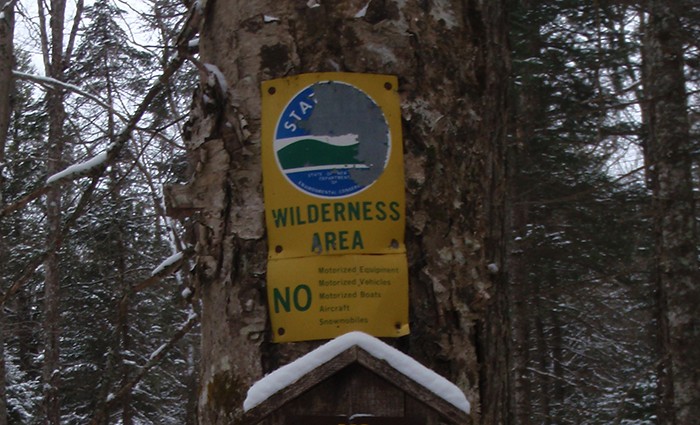
The management of the people’s land in New York, the 3-million acre public Forest Preserve in the Adirondack and Catskill Parks, is a core focus of Protect the Adirondacks. In the Adirondacks, the Forest Preserve spreads across 2.6 million acres and includes over 1.1 million acres.
In the 26 states east of the Mississippi River, there’s 1.3 million acres of Wilderness in the Florida Everglades, 354,000 acres in the Okefenokee Swamp in Georgia, 132,000 acres in Isle Royale in Michigan, and 79,000 acres in the Shenandoah Wilderness in Virginia. The closest large Wilderness area to the Adirondacks is the 61,000-acre Wild River Wilderness in New Hampshire. All told, in the 26 states east of the Mississippi there’s just under 3.3 million acres of federal Wilderness lands.
The paucity of Wilderness lands east of the Mississippi River shows a world out of balance. Outside of the Everglades, the Adirondack Park provides the greatest Wilderness opportunities in the east. The importance of Adirondack Wilderness is brought into sharp relief when the populations of 11 Northeast U.S. states and eastern Canada are considered because such a large population surrounds no other Wilderness system in the country.
Recent New Management Efforts Place a Premium on Facilitating High Public Use, Not Managing It: It’s ironic (or perhaps illustrative) that the DEC has convened this group at the same time that major programmatic changes are underway. The new parking lots/trailhead for Cascade and Porter mountains and Mt Van Hoevenberg will facilitate much higher levels of hikers than have been seen in the past. These trails are designed to accommodate high levels of hikers, and in the case of Mt. Van Hoevenberg, will be shorter. These trails will be connected to a new 1,500-car parking lot, which far exceeds the capacity of the parking lots and roadside parking along Route 73 near the current Cascade Mountain trailhead.
These new facilities will facilitate nearly unlimited public access to Cascade and Porter Mountains and Mt. Van Hoevenberg. While we recognize the public safety benefits to ending highway-side parking on Route 73 in a 55 MPH speed zone, we can’t help but notice the decision to build these new facilities, which while approved in a UMP amendment, was not part of a comprehensive planning effort. These new facilities will shape long-term management of this part of the High Peaks Wilderness for decades to come.
The new shuttle system proposed in the Governor’s current state budget will also facilitate higher numbers of public use in the High Peaks by transporting hikers to trailheads where parking lots are full. It’s difficult to see how this program is part of an overall management program and not simply yet another ad hoc politically-cooked up project, like Frontier Town, like calling Northway bathroom rest areas “High Peaks Information Centers.”
Recommendations for Ways to Improve the Management and Protection of Natural Resources in the High Peaks Wilderness and Associated Wilderness Areas
Below are specific comments and recommendations submitted to the High Peaks Strategic Planning Advisory Group about ways to improve the management of the High Peaks Wilderness Area and other associated Wilderness areas. Please note that the comments below include recommendations. Most of these items should be undertaken through a formal Unit Management Plan amendment process, which should include an open citizens advisory committee, and not through a secret group.
High Peaks Management Changes Should be Made in a Lawful, Transparent Public Process through a UMP Amendment or Revision: The state has already undermined existing law by having this group led by the DEC and not the APA. Any plan or recommendations that come forth from this group should be fully vetted through a UMP amendment and not a separate process. One problem that makes Forest Preserve management challenging in the Adirondacks in the first decades of the 21st Century is the preference of leaders at state agencies, chiefly the DEC, to cut the corners of official procedures, break norms, undermine longstanding laws, and subvert longstanding public processes. This group should be an official advisory committee for a new UMP, it’s meetings should be open to the public, and its deliberations should lead towards a UMP revision.
Now in its 20th year, the High Peaks Wilderness UMP has never been fully implemented. Major projects, such as a public parking lot approved at the South Meadows Road, was never built. There are a number of management actions set forth in that UMP that were never begun.
The 1999 High Peaks UMP is important because it did usher in significant changes to the public use of the area. Campfires were banned in many areas, campsites and lean-tos were brought into compliance, group size limits were established, dogs were leashed, glass bottles banned, among other things. These changes enabled subsequent changes to public use, such as bear canisters.
These changes were made possible, in part, through the active participation of a broad and diverse stakeholders group that represented the full range of public interests in the management and use of the High Peaks Wilderness area.
The High Peaks Strategic Planning Advisory Group should be mindful that its secretive process will likely undermine the value of its ideas.
Recommendation: The group should support the formation of a formal, public High Peaks Citizens Advisory Committee to revise the High Peaks Wilderness UMP to undertake wholesale revision to the management of the area in an open and transparent forum.
New York State Must Invest in the Management and Maintenance of the High Peaks Wilderness and Other Associated Wilderness Areas: One remarkable fact of the Andrew Cuomo years is the reluctance to invest state financial resources in the hiking trails and management of the 3-million acre Forest Preserve, the people’s land in New York. The Governor has spent millions of dollars to build an illegal class II community connector snowmobile trail network, part of the largest expansion of motorized access in the history of the Forest Preserve. The State of New York recently invested over $20 million to build the new Frontier Town Campground, which received for 1,955 visitors (day and overnight) in 2019. The state is spending upwards of $14 million to build the new mid-station lodge at Whiteface Mountain for an estimated 45,000 users. The state has spent millions to build fancy bathroom rest areas on the Northway that they call visitor centers. Yet, the High Peaks has received scant investment in management and maintenance. The lack of investment in the state’s premier Wilderness area is evident in the degradation of the area’s natural resources, the failure to build or maintain high quality hiking trails, poor public information and education, and the complete lack of science used in decision-making.
Recommendation: The State of New York needs to invest at least $100 million in the management of the High Peaks Wilderness.
Restoration and Rehabilitation of Damaged Natural Resources: The APSLMP includes a requirement in UMPs for the “rehabilitation of such portions of the area as may suffer from overuse or resource degradation.” The APSLMP states:
Each unit management plan will also set forth a statement of the management objectives for the protection and rehabilitation of the area’s resources and ecosystems and for public use of the area consistent with its carrying capacity.
These management objectives will address, on a site specific basis as may be pertinent to the area, such issues as:
— actions to minimize adverse impacts on the resources of the area;
— the rehabilitation of such portions of the area as may suffer from overuse or resource degradation;
— the regulation or limitation of public use such that the carrying capacity of the area is not exceeded and the types of measures necessary to achieve that objective;
This type of assessment and planning is important given the land use and public recreation use history of the High Peaks Wilderness area complex. The APSLMP sets forth a clear directive for “the rehabilitation of such portions of the area as may suffer from overuse or resource degradation.” There are many areas of the High Peaks Wilderness complex hiking trail system that would qualify as needing rehabilitation.
The High Peaks Strategic Planning Advisory Group needs to be conversant in this area, among others, of the Adirondack Park State Land Master Plan. The group should hold the APA and DEC accountable for the rehabilitation of degraded and over-used areas of the High Peaks and associated Wilderness areas.
Recommendation: The High Peaks Wilderness Area Complex must be inventoried to identify areas that require the rehabilitation of natural resources as required by the APSLMP.
Build a Real High Peaks Information Center: Adirondack Park planners have historically failed the Park with the politically sited Visitor Interpretive Centers at Paul Smith’s and Newcomb. The poor locations led to low visitation, which made these centers expendable during the Pataki era. Today, these facilities play minor roles in public education in the Adirondack Park and are largely liabilities for the institutions that have stepped up to manage them. The VICs were supposed to educate visitors to the Adirondacks about the Forest Preserve, Adirondack history and ecology. Today, they stand as monuments to poor planning and a huge missed opportunity.
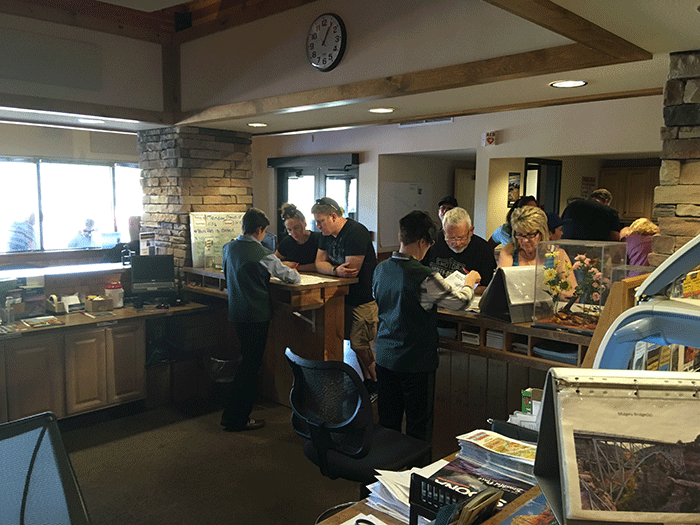
Staff at a National Park Service visitor center helping visitors plan their hikes. The High Peaks Wilderness needs a national park-style High Peaks Wilderness Visitors Center.
Recent efforts at public education about the High Peaks Wilderness sought to piggyback ad hoc educational efforts about this magnificent natural resource area on the backs of highway bathroom rest areas. Adirondack leaders have cheered as the Cuomo Administrations called highway rest areas “High Peaks Information Centers.” Why do we allow bathroom buildings to be called High Peaks Information Centers? Why do we allow this kind political nonsense? The operation of these facilities is not impressive, and we do not believe they are useful for educating the public in preparedness for hiking in the High Peaks Wilderness or about the Leave No Trace ethic.
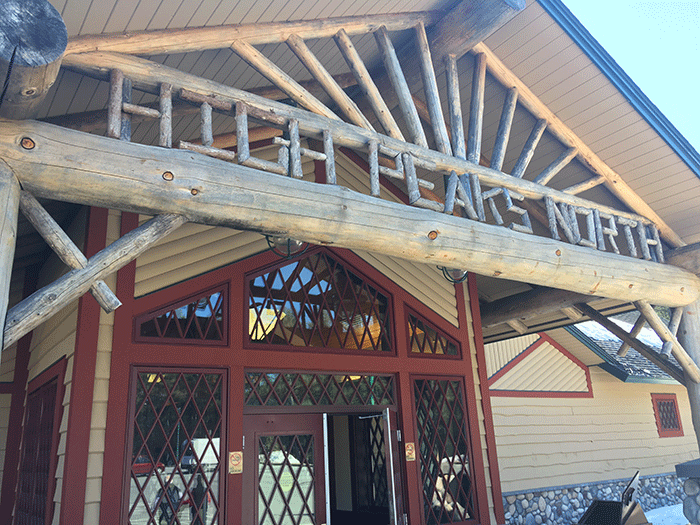
We should not allow bathroom rest stop areas on the Adirondack Northway to be called High Peaks Information Centers. The High Peaks deserves better.
It’s important for the group to understand this history so that these mistakes are not repeated. There is growing recognition about the need for a High Peaks public information center or visitor center. Protect the Adirondacks envisions a facility akin to a National Park visitor information center that is well staffed with knowledgeable people, has supplies to equip an outing or hike, and has lots of public information presented in various state-of-the-art formats for maximum public benefit.
Those who talk about a new High Peaks visitor center of some kind pinpoint locations in Ray Brook or at Exit 29. In our view, these locations would be yet another mistake, another lost opportunity. The best location is Keene Valley. The High Peaks Wilderness, and Adirondack Park, deserves a full-blown High Peaks Information Center modeled after facilities long used in National Parks. The Cuomo Administration needs to commit to funding fulltime, permanent staff for this facility.
Recommendation: A High Peaks Information Center, modeled after the National Park Visitor Information Centers, should be built in Keene Valley.
Scientific Monitoring: The first important part of a comprehensive management program for the High Peaks Wilderness is the monitoring of public use and impacts to natural resources. This has been an institutional weakness at the DEC and APA.
A general rule in recreation management is that there needs to be a link between monitoring and managing actual public use. This has not happened in the Adirondacks, where the management imperative has been largely to facilitate public use. For a number of years, the DEC has listed boilerplate language in various Unit Management Plans about its plans to implement some form of recreation ecology management program. This language called for a combination of Carrying Capacity analysis, Levels of Acceptable Change (LAC) analysis, and the Visitor Experience and Resource Protection (VERP) framework. DEC stated in all of its recent UMPs that these tools would somehow be blended together into a cohesive analytical frame-work. Though this blended analysis was listed in various UMPs, the DEC has never organized any kind of meaningful impact and management monitoring program for the Forest Preserve.
The new High Peaks Wilderness UMP amendment of 2018 took a stab at a new and improved “Wildlands Monitoring Plan” that committed the DEC to organizing and implementing a skeletal recreation ecology management program. Unfortunately, the new “Recreational Resources and Human Uses” section in HPWUMP amendment was poorly written and confused, failed to provide important information, and failed to enumerate a schedule for development and implementation of this plan that was publicly accountable.
While basing a lot of this framework on “Best Management Practices,” little useful information was provided for these BMPs. Subsequent requests for the protocols have been met with “they’re not ready yet for public review.” In the HPWUMP amendment, DEC stated that “the essentials for wildland management” are “planning, education and outreach, frontcountry infrastructure, backcountry infrastructure, limits on use when all else fails and resources both personnel and funding.” The DEC stated that it will rely on six Best Management Practices that include “planning; education and outreach; frontcountry infrastructure; backcountry infrastructure; limits on use; and, financial resources for both personnel and programs.” While the DEC went to great lengths to define some things in its new wildlands monitoring program, the BMPs were not adequately defined and as such were of limited value, which gave the whole enterprise an ad-hoc-make-it-up-as-you-go feel and sharply limited the public in its efforts to try and hold the DEC accountable.
The upshot is that DEC-APA has never been any good at scientific monitoring of public use and impacts to natural resources on the Forest Preserve. The DEC-APA should not reinvent the wheel on these matters. While many have long proclaimed the Adirondack Park to be a great model for the world, we have lost the credibility to crow about a lot of things. Yes, the 3-million-acre Forest Preserve is something to crow about. Yes, forever wild is a great public policy accomplishment. And, yes, the APA Act and the Land Use and Development Plan are exemplary regional land use regulation achievements. But when it comes to rural community development, rural economic development, or public lands management, we have a lot to learn from other places that do it much better than we do.
One exemplary public lands management program for the High Peaks Strategic Planning Advisory Group to investigate is the work of the Interagency Visitor Use Management Council (IVUMC). There are numerous publications and websites. We believe that the professional body of work of people like Jeff Marion of the USGS/Virginia Tech, and active with this group, is highly relevant and very useful for the Adirondack Forest Preserve. Here are useful URLs about the work of the Interagency Visitor Use Management Council:
See the IVUMC visitor management guide. See the IVUMC “monitoring guidebook.” See the IVUMC “visitor capacity” guidebook. See its “relationship between amount of visitor use and environmental impacts” guidebook:
From our review of the work of the Interagency Visitor Use Management Council, their comprehensive wildlands management program appears to offer a lot that would benefit the management of the Forest Preserve in the Adirondack Park. The development of a plan for monitoring public use and natural resource impacts should be viewed as a high priority.
Ideally, public use data would inform decisions about the numbers of hikers desired and appropriate in a given area, on a specific trail, on a mountain summit.
Recommendation: Good data and good science should be used to drive public policy.
Recommendation: DEC should contract with outside consultants who have broad experience in wildland monitoring to help develop a usable program for the DEC-APA in the Forest Preserve. DEC should contract with academic institutions or consultants to complete this important work.
Recommendation: Fully investigate, and bring in national experts for tutorials, all facets of the work of the Interagency Visitor Use Management Council for possible use in the Adirondack Forest Preserve.
Recommendation: The High Peaks Strategic Planning Advisory Group was recently provided the full report from Leave No Trace from its recent review of Adirondack public lands organized by the Adirondack Mountain Club and Adirondack Council. While Protect the Adirondacks has only seen a summary, we find this work to be encouraging with its emphasis on building a robust public education program. If state agencies were to embrace a full-scale LNT management approach in the High Peaks Wilderness it would necessitate changes to the APSLMP and relevant UMPs.
Recommendation: There needs to be a major survey of users of the High Peaks to determine who these people are, where they came from, their economic impact, how they educated themselves before their hike, and their observations and experiences about their hike and the conditions they encountered, and reactions to different management options, among other things. This data would be highly useful to any meaningful planning effort.
Recommendation: User data should use used to develop plans for the peak desired number of hikers in a given area, on a specific trail or mountain peak.
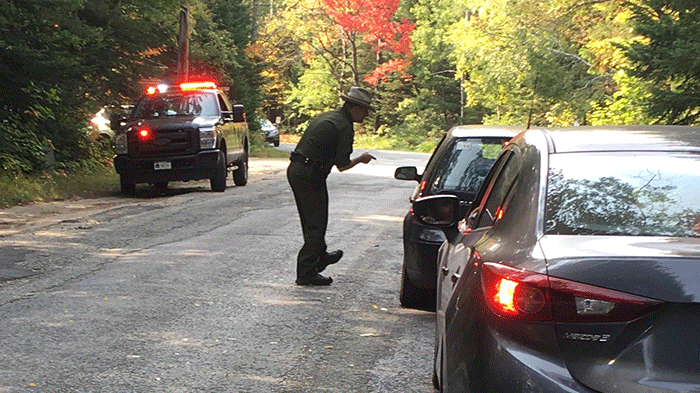
Forest Ranger Scott Van Laer talking to hikers on the Adirondak Loj Road in Lake Placid on a peak day.
Public Education: The second important part of a comprehensive management program for the High Peaks Wilderness is public education. This has been an institutional weakness at the DEC and APA. We need a robust public education system that informs hikers when they are planning their hike, when they arrive at a trailhead, when they are on their hike, and we need to gather data from hikers after they complete their hike.
The DEC website has lots of information, but it is lost because their site is jammed with information. The DEC needs to outsource a Forest Preserve online communication effort about the High Peaks to a professional outdoor education communications entity. This would be an important investment and an important piece in an overall public education outreach effort.
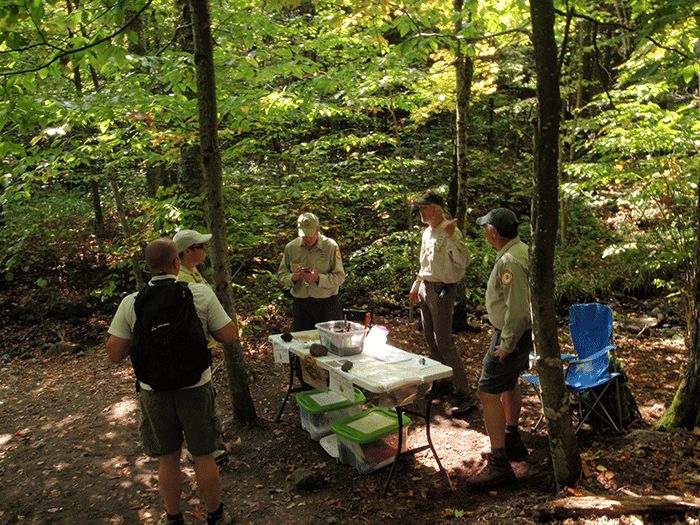
The picture above shows members of the 46ers undertaking education and outreach with hikers at the Cascade Mountain Trailhead.
One of the most significant management programs in the High Peaks is the multi-award winning Summit Stewards program, managed by The Nature Conservancy and Adirondack Mountain Club, which has helped to protect rare alpine summit vegetation on a dozen mountaintops and has educated hundreds of thousands of hikers about Leave No Trace practices for backcountry recreational use. This type of direct public education is indispensable and highly effective. Changes in the management of Forest Rangers have severely limited their backcountry presence and their ability to directly educate large numbers of hikers.
This type of education and outreach needs to be expanded in the High Peaks. Trailhead stewardship needs to be formally organized and could be undertaken so that the busiest dozen trailheads are covered by trained public outreach staff, especially on weekends. Trailhead education needs to be supported by robust online information about hiking in the High Peaks that is updated regularly. Northway rest areas also need to be improved with special displays about hiking in the High Peaks, with appropriate signs on the highway that encourage hikers to stop in, and the Beekmantown station needs a display in French as well as English. The Northway “High Peaks North” station has one display case about hiking preparedness, but nothing about LNT. There are no LNT brochures for visitors to take with them. There is nothing specific about hiking in the High Peaks and hiking etiquette. The new Adirondack Information Center north of Exit 17 on the Northway has zero information on LNT or about hiking in the High Peaks, though it encourages the public to buy the NY Fish & Wildlife app.
Recent efforts and partnerships by the 46rs and Adirondack Watershed Institute are also promising and attempting to fill this critical gap to provide trailhead education. There are many trailheads in the High Peaks that would benefit from this work. These are programs that should be expanded.
Recommendation: Develop and fully integrate public education as a major part of the state’s new management program for the High Peaks Wilderness and other associated Wilderness areas.
Recommendation: Contract with professional outdoor education communications entity to develop a new online outreach/education effort about hiking in the High Peaks Wilderness.
Recommendation: Work to expand trailhead education efforts pioneered by the 46rs and Adirondack Watershed Institute.
Recommendation: Continue vital summit stewards programs with TNC and ADK.
Recommendation: Develop a comprehensive survey that includes gathering data on hikers’ experiences.
Recommendation: New designs for trailhead kiosks should be developed and evaluated to maximize public education opportunities.
Adequate Facilities: The third important part of a comprehensive management program for the High Peaks Wilderness is adequate facilities that provide safe public access the High Peaks Wilderness area and overnight camping while protecting natural resources. This has been an institutional weakness at the DEC and APA. The DEC has approached the public parking issue in an ad hoc, contradictory way. DEC recently clamped down on roadside parking on Route 73 but allows abundant roadside parking on the Adirondak Loj Road. DEC limits public parking at places like The Garden and Roaring Brook but is building new facilities for unlimited public parking for Cascade Mountain.
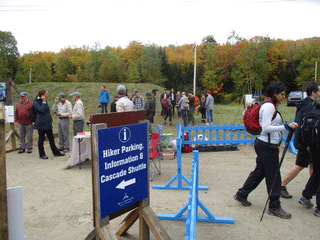 There are a handful of challenging situations for public parking in the High Peaks that would benefit from serious long-term studies rather than the current program of reactive, ad hoc management. Ideally, the peak number of hikers in a given area, on a specific trail or mountain peak would be determined through scientific monitoring (see above) and then partly enforced by the size of the parking area that provides access to a given trailhead. Throughout the Adirondacks public parking lots have been used to limit crowd sizes. The DEC recently did this at the new facilities at Boreas Ponds, and have done this at many other locations on the Forest Preserve across the Adirondacks. The DEC has been largely unsuccessful at using parking lot sizes to manage public use in the High Peaks Wilderness due to widespread roadside parking in certain areas and a recent move to facilitate unlimited public parking in other areas.
There are a handful of challenging situations for public parking in the High Peaks that would benefit from serious long-term studies rather than the current program of reactive, ad hoc management. Ideally, the peak number of hikers in a given area, on a specific trail or mountain peak would be determined through scientific monitoring (see above) and then partly enforced by the size of the parking area that provides access to a given trailhead. Throughout the Adirondacks public parking lots have been used to limit crowd sizes. The DEC recently did this at the new facilities at Boreas Ponds, and have done this at many other locations on the Forest Preserve across the Adirondacks. The DEC has been largely unsuccessful at using parking lot sizes to manage public use in the High Peaks Wilderness due to widespread roadside parking in certain areas and a recent move to facilitate unlimited public parking in other areas.
The Adirondak Loj Road needs a public parking plan. Currently, the road provides nearly unlimited parking between the paid parking at the Loj, ad hoc parking along the South Meadow Road, where new parking spots seems to pop up each season, and all along Adirondak Loj Road. Ironically, a new parking lot at South Meadows Road that was approved in the 1999 High Peaks Wilderness UMP was never built.
Similarly, the Chapel Pond-Zander Scott Trailhead-Round Pond area needs a parking plan, which provides options other than roadside parking in a high-speed zone. A long-term parking plan is also needed for the trailheads to Rooster Comb, The Garden, Hurricane Mountain, Grace Peak, and Ampersand Mountain. The DEC has moved ahead with a new parking plan for Cascade Mountain, which while it will significantly increase the number of hikers at peak times, will also create a safe parking experience for the public.
As far as we can tell, no plan supports the state’s newly proposed High Peaks shuttle program. How many hikers does the state intend to shuttle? What facilities are provided at both ends of the shuttle ride for hikers to wait? How was the number of hikers facilitated by the shuttles factored into the desired number of hikers at a given trailhead? What was the underlying planning undertaken that supports the new shuttle service?
Perhaps the most successful changes implemented in the 1999 High Peaks Wilderness UMP were the changes in overnight camping at Lake Colden and Marcy Dam. These areas have successfully revegetated and become wilder in the last 20 years, while many trails in the High Peaks have deteriorated. New campsite designs have been tried at Marcy Dam in the last two years and a campsite guidance effort is underway. Overnight camping should be fully evaluated as part of a major revision of the High Peaks Wilderness UMP and is probably beyond the immediate scope of this committee.
Recommendation: Public parking and public access should be determined by scientific monitoring of the carrying capacity of an area with the goals of protecting both the natural resources and user experience in an area.
Recommendation: Parking studies are needed to assess all options safe public parking options for the Chapel Pond/Zander Scott Trail/Round Pond, Adirondack Loj Road, Rooster Comb, Hurricane Mountain, Grace Peak, and The Garden areas.
Recommendation: If shuttle services are intended for long-term use in the High Peaks region, then the state should invest in a study to determine the desired number of passengers for each location.
Recommendation: The DEC should undertake a “use” amendment to Article 14 to authorize a certain acreage to build parking lots and trailhead education facilities on the Forest Preserve. We believe that tree cutting for parking lots will likely violate existing protections for the Forest Preserve. (The state may want to use such an amendment to clean up the legality of State Campgrounds as well. The state should not try to expand motorized recreational opportunities in such an amendment.)
Recommendation: A study should be organized to assess overnight camping opportunities and possible improvements throughout the High Peaks Wilderness.
Sustainable Hiking Trails: The fourth important part of a comprehensive management program for the High Peaks Wilderness is building and maintaining sustainable hiking trails. Hiking trail design and maintenance has been an institutional weakness at the DEC and APA.
The management of hiking trails in the Adirondack Forest Preserve has generally not been science-based for design, construction and maintenance. Most hiking trails are remnant 19th-century, fall-line trails that run straight up mountainsides or follow old logging roads. There are a few modern, newly designed, and sustainably constructed hiking trails in the Adirondack Forest Preserve, such as the highly successful Moxham Mountain Trail or the re-routed new trail on Coney Mountain, among a handful of others. Tremendous efforts have been made to “harden” poorly designed trails with stone staircases, bog bridges, or huge water bars, stepping-stone pathways, among other features, which often do not last very long due to the original flaws in the trail’s design. Historically, the DEC and APA have not made the sustainability of the recreational infrastructure and the protection of natural resources within hiking trail corridors a priority in UMPs/amendments.
In many ways the sustainable trail is the link that threads through and ties together comprehensive Wilderness management. The new contour trails under construction on Cascade and Porter Mountains and Mt. Van Hoevenberg help us glimpse a positive future that fulfills the idea of active wilderness management where trails blend in with and enhance wilderness values, rather than undermine them. As things stand now, the new trails on Cascade/Porter and Mt. Van Hoevenberg lay down an example, where theory is turned into practice, and where the art and science of natural resource stewardship and public outdoor recreational management for a Wilderness area are significantly advanced in a way that we have not seen before in the Adirondack Park.
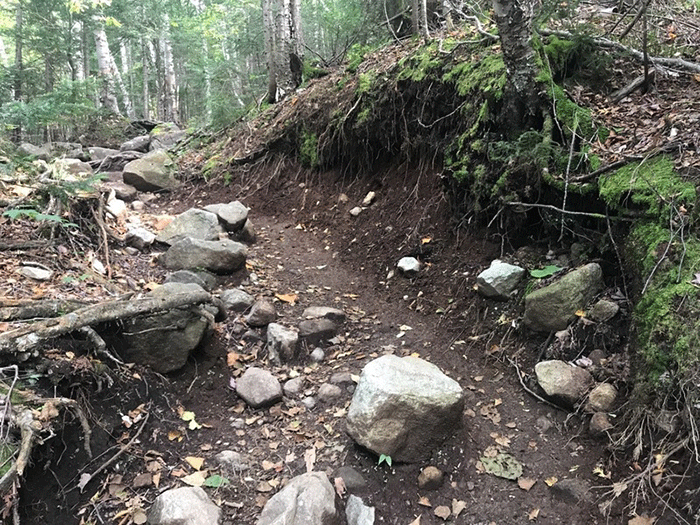
This picture is a small sample of the poorly maintained and poorly designed hiking trails that run straight up the mountainsides of many mountains in the High Peaks Wilderness. It’s high time for the Cuomo Administration to invest in rebuilding the hiking trail system in the High Peaks.
The challenge going forward is the length of time it takes to build these types of trails. The investment is massive per mile, taking the work of several crews. The obstacles for the High Peaks Wilderness should not be the length of time to build these types of hiking trails, but rather the institutional limits within the DEC that have made trail building in the Forest Preserve a low-priority task staffed with seasonal, part-time staff, contractors, and inadequate funding. That $20 million can be spent without any prior planning at the DEC to build the Frontier Town Campground, that was used by less than 2,000 people last year, but only a few hundred thousand dollars can be mustered by the DEC for the hiking trails in the High Peaks used by over 200,000 people says a lot about the low priority at the DEC for managing hiking trails in the High Peaks.
The DEC has long partnered with non-profits for trail construction and maintenance. Some of the longstanding partnerships have deteriorated. Though no one has exact numbers for the backlog of hiking trail work in the High Peaks it has been estimated, based on the 200 miles or so of current trails in the High Peaks, and another 100 miles or so of “trails” on “trailless peaks,” at the current pace of trail construction at Cascade/Porter and Mt. Van Hoevenberg, it will take over 100 years to rebuild the trail system. Clearly, much more needs to be done and new ways need to be found to get high quality trail work completed within a reasonable amount of time.
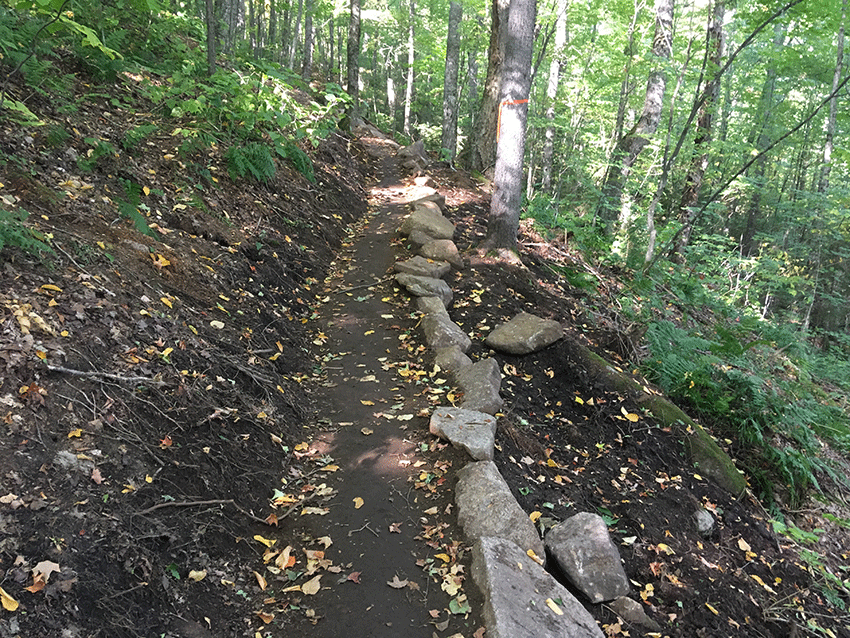
This is a section of the newly designed and constructed hiking trail on Mt. Van Hoevenberg in the High Peaks Wilderness Area. This trail is labor intensive to build and is designed to withstand high use by hikers.
The Forest Preserve in the Adirondacks should be a place where literally hundreds of people go to work each day. This is one profound area where local government, because of decades of resistance to land protection and forever wild, and state leaders, because of not being able to buy and manage lands at the same time (yes, an inability to walk and chew gum at the same time), have failed to effectively plan for the long-term economic and environmental health of the Adirondack Park. The Forest Preserve cannot be lifted up and taken to China. There is no app that will render it useless. There is no decision made in a faraway boardroom that will close it down. The Forest Preserve, through state, local, business contractors, and non-profit actions, should be a place where hundreds are gainfully employed in the management, trails/facilities construction and maintenance, and public education and safety. The Forest Preserve has been the drawing card for millions to come to the Adirondacks, and now it needs to improve long-term management of its trails.
Recommendation: There should be an inventory of the conditions of all hiking trails needs to be organized to assess trails that are currently operational, trails that are un-needed and require closure, trails that require closure and re-routing, trails that require maintenance and upgrades.
Recommendation: The DEC needs to organize at least 10 permanent trail crews dedicated to the High Peaks.
Recommendation: The group should investigate issues around prevailing federal wage and trail crew contracting to fully identify and scope out the problems and search for solutions.
Recommendation: The state needs to develop new partnerships for trail construction and maintenance.
Trail Standards: The ways that hiking trails are managed in the High Peaks Wilderness merits attention for both how they are classified, and the techniques utilized. Both aspects of trail management merit an overhaul.
The 1999 High Peaks Wilderness UMP ushered in the “Trail Classification System” that set management guidelines for Class 1 – Class VIII trails (see attached). This system has been used in every subsequent UMP, but was never formally adopted in the APSLMP. This system needs to be evaluated because the art and science of hiking trail building has advanced prodigiously throughout the U.S. in ways not reflected in the DEC’s current trail classification system, and because the DEC has changed this system in significant ways without adequate public disclosure or review.
The DEC changed the Trail Classification System for class VII horse trails in the Hammond Pond Wild Forest Area to add the use of non-native materials (gravel). While this proposed change was in the draft UMP for the area, it was never identified in DEC’s public presentations to the APA and the APA, and environmental watchdogs, were all caught flatfooted and missed this change. The DEC moved ahead and built new trails with tons and tons of gravel without following proper protocols enumerated in the UMP for consultation with the APA. (The DEC has stonewalled our fact finding efforts on this matter by refusing to provide information in response to a Freedom of Information request submitted last July!) This is illustrative of how easily changes can be made to this trail classification system and that there needs to be greater public scrutiny and review.
Just as the DEC has managed public trailhead parking in an ad hoc and contradictory manner, it has done the same with hiking trail construction and maintenance. In recent years, the DEC has authorized new trail building that conform with the management directives in a Wilderness area, such as the new trails under construction on Cascade Mountain as discussed above, while at the same time authorizing extensive wooden staircases to be constructed. The wooden staircases do not conform with Wilderness management guidelines and are likely to fall into disrepair within a few years. There was an absence of public review or discussion around the wooden staircases on Mount Colden and the Ore Bed Trail. This trail maintenance technique merits a wider discussion as part of a comprehensive trails standards review.
Recommendation: The “Trail Classification System” first developed in the 1999 High Peaks Wilderness UMP, and used in all subsequent UMPs, should be updated and revised.
Recommendation: The UMP trail classification framework needs to be revised, and all trail classifications should be adopted as part of the APSLMP, not managed ad hoc.
End the Destructive Myth of Trailless Peaks: Trailless peaks are not trailless. Many of the “trailless” peaks see several thousand hikers each year. Many of these peaks, such as the Santanoni Range, Seward Range, Dix Range (other than Dix Mountain), Street and Nye, among others, have a maze of herd paths. These trails negatively impact the natural resources on these mountains.
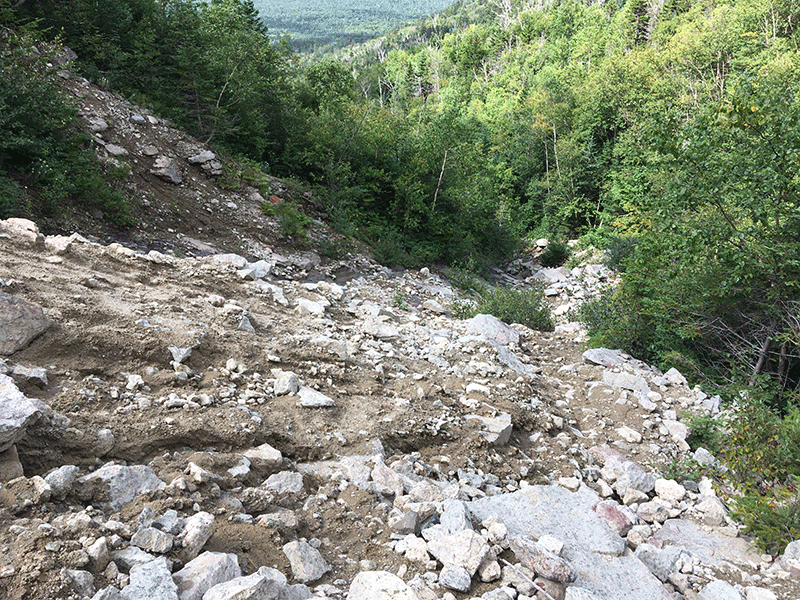
A view of the route on the degraded slide on Macomb Mountain, a trailless peak among the Adirondack 46 High Peaks.
Recommendation: New sustainable hiking trails should be built to access all of the so-called “trailless peaks” that are part of the 46 High Peaks. These trails should replace to maze of environmentally degrading herd paths.
Professional Trained, Credentialed Wilderness Managers Needed at the DEC-APA: Most personnel at the DEC who manage the forever wild Forest Preserve are trained foresters who went to college to become foresters to learn the art and science of cutting down trees, which was their first love. A career in forestry at the DEC finds these people managing the public Forest Preserve, where their work is supposed to be guided by the forever wild ethos. The DEC has no effective civil service titles for Wilderness managers and there are no career tracks at the DEC for a bona fide Wilderness manager to advance up through the bureaucratic ladder to a position of authority or influence. There is a clear civil service process for a forester to rise to the top of the DEC pyramid, but not for a wilderness manager. We desperately need trained, experienced, professional wilderness managers at the DEC to effectively manage the Forest Preserve. The APA also needs a professional Wilderness manager as part of its state lands team.
Recommendation: DEC should create positions for professional Wilderness managers who can rise through the ranks to be regional Natural Resource Supervisors and top staff within the Division of Lands and Forests.
Recommendation: The APA should have a professional Wilderness manager as part of its state lands team.
Trailhead Registration Data: The user data for the High Peaks and associated Wilderness areas is remarkable for its gaps. In the year 2018, the most recent where data is available, major trailheads, such as Giant Mountain, Ampersand Mountain, The Garden in Keene, and the Seward Range, among others were incomplete, frustrating efforts to assess to the total impacts to the region. Trailhead data for Noonmark Mountain and Round Mountain are full of gaps. Data for the Sentinel Range are a mess.
Because of the poor quality of trail register data long-term trends cannot be meaningfully assessed in most areas. It appears that valid long-term trailhead register data from trailheads along the Adirondak Loj Road and Cascade Mountain, where for his long career Forest Ranger Jim Giglinto made collection and transmittal of trailhead register data to the DEC office in Ray Brook a priority, are valid. We should all be grateful for Giglinto’s commitment, and we should openly wonder about why the current system has been a failure.
Recommendation: There needs to be systemic changes to ensure that trailhead register data is gathered and organized in order to accurately assess short-term and long-term trends.
Transparency in Budgeting and Spending in the High Peaks Wilderness: State spending in the Adirondack Forest Preserve is opaque. The DEC needs to open its books and show the world how it spends the people’s money on the people’s lands. This information has been incredibly difficult to get as the DEC treats it as some kind of national security secret. The DEC needs to be publicly accountable and transparent and end its practice of withholding public information.
Recommendation: All state spending in the High Peaks Wilderness and Adirondack Forest Preserve 2011-2019 should be catalogued, detailed, and released to the public to evaluate its efficacy.
Management of Dams in the High Peaks: In recent years dams at the Flowed Land and Marcy Dam were allowed to breach. It should be official policy that all dams in the High Peaks Wilderness should be allowed to breach and removed.
New Partnerships: Clearly the task of managing the High Peaks Wilderness has grown well beyond the ability of the DEC-APA. There have been long-term partnerships that have proved highly successful such as the Summit Stewards program. There are many other partnerships that need to be developed with local governments, academic institutions, businesses, and non-profits to plug management gaps. An effort that identifies needed activities, such as trail construction/maintenance or public education or environmental remediation or research, among other things, is badly needed. If an array of new partnerships are successfully created in the years ahead, the state agencies and general public would benefit from some kind of High Peaks Wilderness Management Council to work on these issues long-term to ensure successful implementation of needed improvements and reforms.
Give Mt. Katahdin-Style Permits/Reservations a Fair Shake: While Protect the Adirondacks does not hold out any confidence that the DEC is willing to even explore the options of a permit/reservation system for certain parts of the High Peaks Wilderness, we believe that the time has long passed to study this issue. We all make reservations at restaurants and movie theaters, at hotels, and on airlines. The beauty of a reservation is the certainty of getting to do one’s desired activity. As it stands now, DEC is managing public use through de facto permits via parking spaces or shuttle seats in some locations.
A rational system would not be based on first-come-first-served opportunities, which disadvantages visitors to the region, or through de facto permitting by parking space or shuttle seat. A rational program would manage public use that is protective of the resource and also is protective of the visitor by guaranteeing their opportunity to climb their desired mountain through a coherent management program.
Recommendation: Investigate the pros and cons of longstanding permits systems for wild areas, such as Mt. Katahdin in Maine or the Boundary Waters in Minnesota, among many other places, for their utility in the High Peaks Wilderness.
Protect the Adirondacks will continue to press for major changes in the management of the High Peaks Wilderness area.

